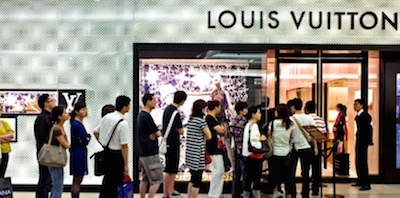International markets saw a 16 percent increase in Chinese outbound travelers, but closer to home, in Greater China, there was a 7 percent decline in tourism for the first half of 2016, according to the China Outboard Tourism Research Institute.
COTRI found that there were 64 million border crossings from Mainland China between January and June of 2016, resulting in a growth rate of 3.4 percent. Much of the luxury market relies on Chinese outbound travelers who visit brand stores and duty free shops to make high-end purchases as a method to avoid the high tax at home.
COTRI released its latest statistics during the 6th Biannual ITSA conference, organized by the International Tourism Studies Association based in Beijing, Washington and the University of Greenwich in the United Kingdom. This year’s conference was held Aug. 17-19 in Greenwich.
Passport stamps
Although visits to Greater China—which includes Hong Kong, Macau and Taiwan—declined, nearby Thailand, South Korea and Japan saw high numbers of arrivals for the first half of 2016.
By quarter, Greater China saw a 9.9 percent decrease in travelers during the first quarter, but a decline of 3.7 percent for the following quarter.
According to COTRI, on a global scale travel was down 22.4 percent in the first quarter and 12.5 percent in the second quarter. This resulted in the global growth rate improving by 2.4 percent and 4.3 percent in the first and second quarters, respectively.
COTRI also found that for the first time less than half of Chinese outbound trips were made within Greater China during the second quarter of 2016. Outbound trips totaled 15.8 million, split between Hong Kong, Macau and Taiwan, with the rest of the world seeing 18.0 million arrivals.
By half year, Greater China counted 32.3 million arrivals from Mainland China, compared to the 31.7 million Mainland Chinese who visited destinations around the globe.
By COTRI’s estimates, the remainder of 2016 will see the market share of Greater China dipping below the 50 percent level.
“At first sight a growth rate of 3 percent seems very dramatic, especially after all the double-digit growth rates witnessed during the last decade,” said Prof. Dr. Wolfgang Gerog Arlt, director of COTRI, in a statement. “However, a closer look reveals that it is mainly the dramatic reduction of the number of Mainland Chinese from Guangdong visiting Hong Kong, which has led to this slowdown.

Chinese consumers outside Louis Vuitton
“Access restrictions for residents of the neighboring city Shenzhen, as well as the growing allure of Seoul and Tokyo, as alternative shopping destinations have resulted in the negative trend seen in the Hong Kong SAR,” he said.
During his presentation, Mr. Arlt suggested that Chinese tourists may become fond of visiting destinations such as Italy, Eastern Europe, Australia and New Zealand. These places are considered safer to some degree after terrorist attacks have occurred in a number of frequented European countries and Thailand as well.
To this point, luxury brands have taken a stake in the Australian market.
Luxury retailing in Australia is projected to be a $2.4 billion industry by 2019-20, according to a report by IBISWorld.
IBISWorld’s “Luxury Retailing in Australia” report says the country’s relatively stable economy has given its residents more disposable income, leading to more luxury purchases. Due to Australia’s favorable market for luxury goods, many brands have aggressively expanded their operations in the region (see story).
from Travel and hospitality – Luxury Daily https://www.luxurydaily.com/31-7m-mainland-chinese-consumers-traveled-abroad-in-h1-2016-report/
via Your #1 Source to Finding Luxury & Designer Goods, Handbags & Clothes at or Below Wholesale: Click Here.


No comments:
Post a Comment